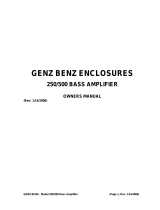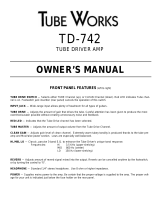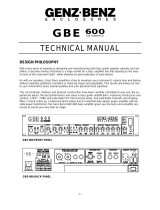Page is loading ...

NEOX400-210T
OWNER’S MANUAL
CONGRATULATIONS !
Your new NEOX400-210T Combo is designed with the power, features and performance that
today’s professional bassists desire.
The solid yet lightweight cabinet construction and powerful Neodymium dual 10”, 250 watt
loudspeakers provide a solid platform for the versatile, compact NEOX400 amplifier. The circuit
design, features and physical layout have been carefully calculated to deliver the best performance
and reliability in bass guitar amplification.
The NEOX400-210T features sturdy jacks and controls, 12AX7 tube and solid state FET preamps,
footswitchable channels, tone shaping filters, 5-band active EQ, a balanced direct output and an
industrial duty bipolar power amplifier with Toroidal power transformer, providing the tools and
versatility to sound your very best on stage.

TECHNICAL INFORMATION
The first stage of the NEOX400-210T preamp uses a low noise bi-fet linear scaling amplifier with a 2 pole low
cut point at 23 Hz to prevent excessive speaker cone excursion and intermodulation distortion. Additional
bandwidth roll-off is provided at 20 kHz for RFI suppression. The variable gain stages are a feedback-divider
type control, one of which is all solid state and the other utilizing a cathode follower (tube), each providing a
maximum gain of about 30 dB. On the tube stage, variable non-linear loading creates a smooth and natural
sounding overdrive rich in harmonics. These foot-switchable and blendable gain stages feed 3 footswitchable,
user adjustable signal shaping filters and the 5 band active equalizer. These EQ filters provide over 12 dB of
boost and cut, with center position flat. The output amplifier feeds the master volume control and fully protected
power amplifier. A low noise differential drive output amplifier is provided for the direct output (switchable pre/
post EQ and ground lift) and is phantom power protected.
The power section consists of a low distortion bipolar power amplifier with integrated limiter which allows
gradual overload without sudden loss of feedback control of the speakers. The output is rated at 425 watts
RMS at 4 ohms. The amplifier topology is low feedback class A-B with servo control of bias and DC offset.
Also provided is on board output limiting, dual slope integrated VI limiting, solid state thermal protection, short
circuit load protection, dc fault protection and RFI suppression. All amplifier status points are indicated on a
dual color led array. This amplifier uses heavy duty copper based bi-polar power transistors directly mounted to
a fan cooled extruded aluminum heatsink tunnel.
An important and not commonly discussed specification is the power amplifiers ability to deliver rated power
into a reactive load. All speakers present a reactive load to the amplifier, reducing real world driving ability. The
power section of the NEOX400-210T amplifier is rated to deliver full power into a reactive load with a 45
degree (leading or lagging) power factor phase angle. This is one important reason Genz Benz amplifiers
sound so big.
FRONT PANEL
FEATURES
The following feature set is included on the NEOX400-210T. These features were developed based on
usability and are the result of input from veteran players from around the country. It is important for an amplifier
to reflect the real needs of the players using them. We feel that this amplifier does just that.
Input — The ¼” input has switchable sensitivity. With the switch in the passive position, the preamp presents a
higher gain and input impedance which is tailored to the characteristics of passive pickups. The input
impedance of the amplifier’s passive input is set high enough to prevent interaction with the high output
impedance of all commonly used passive pickups, including magnetic, piezo-ceramic and piezo film types.
With the switch in the active position, the preamp presents a lower gain and input impedance which is tailored
to active pickups. An active pickup is, for all practical discussions, any pickup that uses pre-amplification
between the pickup element and the amplifier input. The purpose of this pre-amplifier is to buffer the high
impedance signal from the pickup element (magnetic, piezo-ceramic, piezo-film etc) and convert it to a higher
level, lower impedance form. It is common for a bass with active pickups to have higher output level and longer
sustain because only a small portion of the energy required to make the electrical signal comes from the
vibrating string. The majority of the energy comes from an external power source such as a battery. Additional

features may be provided with the active pickup, such as equalization, volume control and compression.
Tuner Output Jack — The “tuner output jack is provided to allow a tuner to remain plugged into the amplifier
while playing. This output remains active when the “mute switch is pressed, allowing for tuning your
instrument while not sending signal to either the “direct output or the speaker. Signal level of -30dB (typical
hot bass level) will drive all known tuners.
Input Signal Mute Switch — The input on the NEOX400-210T bass amplifier includes an “input mute switch.
With this switch, you can place the amplifier (and the direct output) in standby mode between sets without
having to change any of your volume settings. This feature is especially handy during the set when using the
tuner output since you will still be able to use your tuner without having sound come from the amplifier or P.A.
system. No more re-patching or fumbling in the dark! A red LED turns on when the input mute is active,
reminding you that you are in “stand-by” mode. This feature is also controlled by the optional 4 button
footswitch.
Input Gain Controls & O/L LEDs — The “input gain controls, in conjunction with the signal and clip LEDs,
allow you to adjust the preamp input gain sensitivities to the instrument you are playing. Basses can have an
output level from a few thousandths of a volt to several volts. Generally, you want to see only an occasional
flash of the red clip LED when you really hit the string hard, then adjust the master volume control for playing
volume. Distortion of the preamp gain stage will occur when the red clip LED is illuminated, so plan
accordingly. The best signal to noise ratio will result with the above method. Setting your playing volume will
be a combination of the “FET gain control (FET channel), “TUBE gain control and “TUBE volume
control (TUBE CHANNEL) and the “master volume control, depending in part on individual preference.
Intentional overloading of the tube channel may be desirable and the O/L LED indicates that you are operating
the tube preamp stage in the overdrive mode. The FET and TUBE preamps are switchable and mixable. These
features are also controlled by the optional 2 button footswitch. Both CHANNEL O/L LEDS are active at all
times monitoring each channels audio level, independent of channel switch position.
Signal Shaping Switches and Controls — There are 3 separate shaping filters on the NEOX400-210T. The
L.F. EXTEND lowers the low frequency roll-off response of the preamp (between 30 and 45 Hz) to allow the
full effect of 5+ string and extended scale instruments. The amount of extension is adjustable depending on
the setting of the corresponding control. Use this function with care due to the power of this amplifier. The “MID
SCOOP function introduces a midrange scoop at approximately 800 Hz, with a lower “Q” than typical
equalization provides. The amount of scoop is adjustable with the corresponding control. The H.F. ATTACK
function increases brightness and sparkle (approximately 4KHz) of the signal, allowing exaggeration of
percussive effects and string sound. The amount of attack is adjustable with the corresponding control. All 3
filters are footswitchable by the optional 4 button footswitch.
Active 5 Band Equalization — The “active 5 band equalization used in the NEOX400-210T amplifiers is
composed of 1 shelving low frequency control, 3 peaking midrange controls and 1 shelving high frequency
control. These filters are not interactive and are effective as an advanced tone control system. The filters have
a cut/boost range of +/- 12dB and a smooth, musical sounding response.
Low Frequency - 80 Hz
Low-Mid Frequency - 200 Hz
Mid Frequency – 500 Hz
High-Mid Frequency – 1250 Hz
High Frequency - 4000 Hz
Master Volume — The “master volume control is post-eq, and adjusts the signal level sent to the power
amplifier. Best results are usually obtained when this control is set between the 9 o’clock and 3 o’clock
position.
Master Section Status Indicators —
• The “power LED indicates that the amplifier is on and the low voltage regulated power supplies are active.
• The “protect LED indicates that the amplifier is in “protect” mode and the output relay is de-energized. This

LED will illuminate for approximately 3 seconds during power switch-on and switch-off. It is normal for this LED
to glow while continuing to monitor the internal conditions for about 3 seconds after the protection relay has
closed. It will also illuminate during any internal fault condition. If this happens, turn the amp off and consult a
repair technician.
• The “thermal LED indicates that the amplifier has overheated, engaged the protection circuit and shut down.
This circuit is self-resetting when the offending condition (blocked air vents, foreign body stuck in fan, etc) is
corrected. This LED will also flash for a brief time at turn-on and turn-off, indicating that the amplifier protection
circuits are operating. An additional feature of this LED is that it will illuminate about 15 degrees F. before
amplifier thermal shut-down, as a reminder that the operating conditions are too hot.
• The “signal LED indicates that the power amplifier is receiving signal (over several watts output) and all
is well!
• The “limit LED indicates that the power amplifier has reached maximum power and the limiter threshold
has been crossed. Driving 6dB beyond this point, the amplifier will gradually begin to clip.
• The “output limit switch engages or bypasses the internal soft clip limiter. This limiter allows simulation of
output saturation as the amplifier nears its maximum power. The limiting action is particularly musical
sounding, even when driven hard.
REAR PANEL
FEATURES
Direct Output — This is a studio quality, fully active transformerless balanced “direct output, with “pre-post
equalization switch.
With the “pre/post switch in the “pre” position, the direct output receives its signal directly from the pre-amp
input buffer amplifier with no tonal modifications. This is a pre gain control, pre eq output, with the best signal
to noise ratio. Most recording and sound reinforcement companies will want to use this position since changes
you make to your stage sound will not affect this output.
With the “pre/post switch in the “post” position, the direct output receives its signal from the output of the 5
band equalizer. This feature allows for additional flexibility in some situations, but is often not desired for
recording or live sound reinforcement.
A “ground lift switch is provided which opens pin 1 (shield) on the direct output to prevent ground loops. Use
the position that results in a minimum of noise.
The output level is nominal line level (adjustable to –30 or 0 dB), pin 2 hot. This output is fully protected from
the effects of phantom power provided by the mixing console and does not require phantom power to operate.
Effects Insert Jacks — The “effects insert jacks are provided to allow access to the pre-equalization signal
for the purpose of inserting signal processing equipment such as compressors, chorus, delay & reverb
processors. “Send (output) and “return (input) are nominal +4 dB level. “Series” devices (such as
compressors and gates) require that the signal flow out from the send jack on the amplifier, through the
processing device and back into the return jack on the amplifier. Parallel or mixed signal devices (such as

chorus, delay and reverb processors) require that the signal flow out of the send jack on the amplifier, through
the unit where it is split into a dry (unaltered) signal and a wet (processed) signal. On the processing unit, you
will use the mixed signal output to return the signals (both wet and dry) to the return jack on the amplifier. The
ratio between the wet signal and the dry signal is heard as the amount of effects added back to the original
signal, which is controlled by the mix knob (also called “balance”) on the effects processor. Set the input
sensitivity on the effects processor according to the processor manufacturer’s instructions. The “effects send
jack may also be used as an auxiliary output to drive a direct box, tape deck etc. This output is
preequalization, and pre master volume. The “mute switch will shut this output down when engaged.
Foot Switches — The NEOX400-210T is fitted with jacks for two different types of footswitch. The 2-button
footswitch (included) controls channel switch and channel mix functions. Any standard latching 2-button
footswitch with TIP-RING-SLEEVE connector will work, provided there are no LEDs in the switching path. The
4-button footswitch uses a 5 pin “DIN” connector and controls the mute and shape filters. This footswitch is
unique to Genz Benz due to the complex nature of the functions and must be factory supplied.
Speaker Output Jacks — The NEOX400-210T features two standard 1/4” speaker jacks plus one Neutrik™“
Speakon NL-4 connector. Minimum recommended total load impedance is 4 ohms. The total impedance of
the combo speaker configuration is 4 ohms. It is not recommended that an external speaker cabinet be used
with this combo. A Phastic plug has been inserted at the factory to prevent the use of this jack.
CABINET FEATURES
Construction — Built from domestic and Baltic Birch plywood, the NEOX400 is sold yet lightweight. The
porting system also strengthens the side panels. Our unique edge-lift handles offer easy transport.
Speaker Configuration — The NEOX400 combo is loaded with two of our GNX10250, 8 ohm loudspeakers
and GBE 4941 compression bullet tweeter. This combination is ideal for producing the clarity and versatility of
the NEOX400 amplifier. Total cabinet impedance is 4 ohms. Use of an additional speaker cabinet is not
recommended.
Internal Crossover — The NEOX400-210T uses a 12 db / octave crossover network which includes our LTP
tweeter protection and a 100 watt tweeter level control.
SPECIFICATIONS
Power rating: 425W @ 4 ohms
Cabinet impedance: 4 ohms
Frequency response: 45 Hz to 18K Hz
Dimensions: 28 1/4” H x 21 1/4” W x 16 1/2” D
Weight: 66 lbs.
GENERAL SAFETY INFORMATION
Power is supplied to the amplifier through an IEC type detachable cord set with a mains connector, fuse
holder and internationally rated 115/230 Volts - 50/60 Hz toroidal power transformer. For our international
touring players, an external mains line voltage switch is provided, with a fuse size chart printed on the rear of
the unit denoting the power supply configuration and fuse size that the unit has been rated for. International
IEC type cord-sets are available for a variety of international power supply sockets. The main’s fuse (and a
spare) is located in a slid-out drawer in the bottom half of the IEC connector.
Common sense (as well as the law) dictates that you do not operate the unit where it will be exposed to
moisture or rain, excessive ambient heat (over 115 degrees F / 40 degrees C) or without a properly grounded
A.C. power source. Never remove the ground pin from the A.C. power connector.
Ventilation is required to keep this amplifier from overheating. Do not block air flow over heat-sinks at the
rear of the unit.

Rev. 1
CAUTIONS
• Never set an amplifier on anything that will tip over or collapse under its weight.
• These amplifiers are capable of producing sound pressure levels that may cause permanent hearing loss.
• There are no user serviceable parts inside these units. Always consult a qualified service repair facility for
service. THE HEATSINK MAY BECOME VERY HOT!!! WARNING!! DO NOT TOUCH.
The use and operation of this device constitutes an agreement of full release of any and all liability connected
with its use. Only persons familiar with the operation of high-powered audio equipment should attempt to
operate this device. In addition, by the use of this device, user agrees to hold both GENZ BENZ
ENCLOSURES, INC and its designers, sales agents and all other affiliates and related parties harmless in the
event of any accident, injury, damage or loss resulting from such use. Manufacturer’s sole responsibility is to
provide a warranty on the specified performance of the product under normal conditions for a period of 3
years.
THREE YEAR LIMITED WARRANTY
TRANSFERABLE
Genz Benz Enclosures warrants the NEOX400-210T speaker enclosures and electronics to be free from
defects in materials and workmanship, for a period of 3 years from the date of purchase, when purchased
from an authorized Genz Benz dealer.
This warranty does not cover wear and tear incurred from the normal designed use of the product.
This warranty is only effective if a copy of the original sales receipt is presented at the time of warranty
service.
This limited warranty is completely transferable to any subsequent buyer as long as the original sales receipt
is transferred to such subsequent buyer. See your warranty card for all details.
ALL WARRANTY SERVICE MUST BE PERFORMED BY A GENZ BENZ AUTHORIZED SERVICE CENTER.
Before returning any unit to the manufacturer for service, a RETURN MERCHANDISE AUTHORIZATION
(RA#) must be obtained by calling 480-941-0705.
7811 E. Pierce St. Scottsdale, AZ 85257
Ph: 480-941-0705 Fax: 480-946-2412
www.genzbenz.com
/








